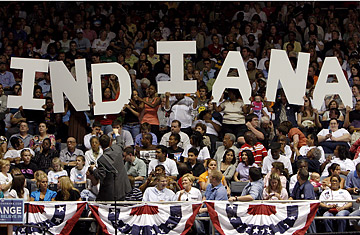
Bud Richard, and voters like him, may ultimately determine this year's presidential race. But if he's any indication of Indiana's political preferences, pollsters will have a hard time calling the Hoosier State Nov. 4. On a recent afternoon, the 65-year-old retired carpenter sat comfortably on a lawn chair in this Ohio River city's main square, selling jars of home-grown honey. The registered Republican twice voted for George W. Bush, but makes one thing clear: "I've never voted for a straight ticket in all my life." He's underwhelmed by this year's candidates, so isn't rushing to pick one.
"If Obama's going to win ," Richard explains, referring to Sen. Barack Obama, the Democratic presidential nominee, "he's got to show some substance. Plus, you can't have O.J.T. in a job like that." (O.J.T., of course, would be On-the-Job-Training.) His skepticism is deepened by Sarah Palin, the Republican vice-presidential nominee. "That gal seems like a real nice person," Richard says, referring to the Alaska governor, "but the fact that she's a woman could hurt. The country might not be ready." Nor is the faltering economy going to help Republicans here. "I'm waiting for Reagan's 'trickle-down' economics to trickle down to me," the portly Richard says, lifting his baseball cap to cool his head in the breeze.
Richard's pragmatism reflects Indiana's. The state regularly elects a majority of Democrats to its Congressional delegation, but no Democratic presidential nominee has carried Indiana since LBJ. Obama hopes to break that drought by capturing Indiana's 11 electoral votes. And a poll published Wednesday in the Indianapolis Star puts him ahead of Sen. John McCain, the Republican presidential nominee, 47% to 44%, with 6% of respondents undecided.
The key factor driving the desire for political change here is economic pain — even in traditional Republican bastions like Elkhart County, in the state's Northeast corner, where the closure of several RV plants has pushed the unemployment rate to 9.3%. Even incumbent Republican governor Mitch Daniels is presenting himself as an agent of change.
Perry County, home to Tell City (pop. 7,500), is known as a stronghold of Democrats, albeit more so of the Dixiecrat variety -- President Bush carried the county in 2000 and 2004. It delivered one of Obama's lowest tallies in last May's Indiana Democratic primary, when he captured just 35% of the vote against 65% for Sen. Hillary Clinton. Tell City's mayor, Barbara Ewing, was a staunch Clinton supporter partly because, she says, "She's been in politics for years. I thought we could get two [Clintons] for one."
Still, she says, once Obama won the nomination, local Democrats swung behind him. "We saw enthusiasm for Barack ," she says of the night local party activists gathered to watch the TV broadcast of his acceptance speech. "People realized that as voters, as Hoosiers, this is a crucial time for our country." Given Southern Indiana's social conservatism, Ewing concedes some voters may be energized by Palin. So, what role will Obama's blackness play in a region with no deep record of electing people of color? "In reality," Ewing said, carefully choosing her words as she at a bench outside city hall, "I think it could be an issue for some people here. That's just the sad truth."
But Obama has other factors working in his favor: His campaign has built an extensive grassroots network with 32 field offices in the state. He is familiar to voters in Indiana's Northwest corner, which falls within the Chicago media market. And he is also expected to perform well in Indianapolis, given its large black population. Indiana Secretary of State Todd Rokita expects 65% voter turnout — the highest since 1992 — largely because of more than 230,000 newly registered voters, many of them signed up by the Obama campaign in college towns such as West Lafayette, South Bend and Bloomington. Obama has visited the state five times since July.
McCain campaign's structure here is comparatively weak. Rather than opening dedicated field offices, the campaign has bundled operations in county Republican headquarters that also manage outreach for Gov. Daniels' reelection bid. In Perry County, and certainly much of the state, McCain is hardly visible against the "Farmers for Obama" signs attached to scores of trees along two-lane roads. Or the barrage of Obama TV ads. Indiana Republicans proudly say they don't need to pay for advertising because the Democrats are merely playing catch up. "We want [the GOP] to put resources in the true battleground states," says Kevin Ober, the Indiana Republican Party's executive director, adding: "The polls are already showing us ahead." Jonathan Swain, spokesman for Obama's Indiana campaign, concedes the party is running from behind in a state where it has not campaigned actively in 40 years. Still, he says, the polls show that "we've got good reason to think our goal is within reach."
Indiana may be the kind of purple state Obama has long envisioned as falling his way. But to win over Hoosiers, Obama needs to more aggressively explain to voters like Richard why his economic platform will do more for them than McCain's. In the meantime, Richard is waiting. "I may not decide who the right man for the job is until I wake up on election day," he says.
